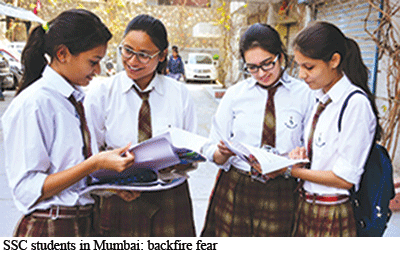 The maharashtra state education ministry’s decision to overhaul the class IX curriculum of 21,000 schools affiliated with the Maharashtra State Board of Secondary and Higher Secondary Education (MSBSHSE), has infused them with gloom as they have little time to prepare for it before most schools reopen in the first week of June. Under a government resolution (GR) dated April 27, schools affiliated with the board will have to scrap several subjects and introduce new ones. The new curriculum is also likely to discomfit 1.7 million secondary school-leaving students expected to write MSBSHSE’s class X exams next year (2018).
The maharashtra state education ministry’s decision to overhaul the class IX curriculum of 21,000 schools affiliated with the Maharashtra State Board of Secondary and Higher Secondary Education (MSBSHSE), has infused them with gloom as they have little time to prepare for it before most schools reopen in the first week of June. Under a government resolution (GR) dated April 27, schools affiliated with the board will have to scrap several subjects and introduce new ones. The new curriculum is also likely to discomfit 1.7 million secondary school-leaving students expected to write MSBSHSE’s class X exams next year (2018).
The new curriculum tweaks several subjects (information & communication technology, personality development, geography and economics) and introduces new ones such as technical education. But the curricular change which has outraged principals and parents is a proposal to do away with the option of ‘general maths’ or ‘maths’ — a choice available to class IX and X students since 2008. Despite MSBSHSE maths covering the same ground, ‘general maths’ is relatively easier and chosen by students planning to enter the arts stream in Plus Two. Students who are more confident about their maths proficiency and plan to enter the science and commerce streams write the regular maths paper.
Under the new curriculum, the ‘general maths’ and maths paper will be replaced with one maths paper. The reform is justified on the ground that students in each grade will write the same exam papers. “It has been brought to our notice that many schools, irrespective of proficiency, were compelling all students to choose ‘general maths’ to show better class X results,” says Krishna Kumar Patil, secretary of MSBSHSE.
Some school managements however, view this curriculum reform as regressive since the relatively easier ‘general’ maths made it possible for students with learning difficulties to clear the state board’s class X exams in which maths is a compulsory subject. “Students should have the flexibility to choose subjects based on the stream they intend to enter in junior college (classes XI-XII). Even with maths exams of two levels of difficulty, MSBSHSE’s SSC (secondary school certificate) curriculum is less flexible than of the Council for the Indian School Certificate Examinations’ class X ICSE curriculum, which allows students to totally drop maths after class IX,” says Priyanka Rajani, principal of the state board-affiliated Vidyanidhi High School and Junior College of Science, Mumbai.
Though the April GR has given broad indications of the contours of the new syllabus, the rigour of the new maths curriculum will be known only once textbooks commissioned by MSBSHSE become available in early June. Several academics fear the new common maths curriculum for classes IX and X will fall between two stools. It will prove difficult for students who would have opted for general mathematics while being too easy for students with higher maths proficiency. This is likely to place students from Maharashtra state board schools at a disadvantage compared to students of the two national boards — CBSE and CISCE — in terms of maths proficiency, adversely affecting their chances of faring well in national entrance exams such as IIT-JEE.
Already CBSE and CISCE-affiliated schools with rigorous curriculums designed to promote deeper understanding of subjects and develop students’ critical thinking and analysis skills have an edge over state board schools which have a reputation for ill-designed curriculums known to promote rote learning, as indicated in the National Achievement Survey (NAS) 2015. Based on the data provided by NCERT’s NAS 2015, EducationWorld ranked MSBSHSE #6 in India, well behind CISCE and CBSE (EW June 2016).
Meanwhile principals and parents in India’s premier industrial state are keeping fingers crossed that they won’t suffer because bureaucrats have rushed through a curriculum reform around which angels would have tread carefully.
Dipta Joshi (Mumbai)